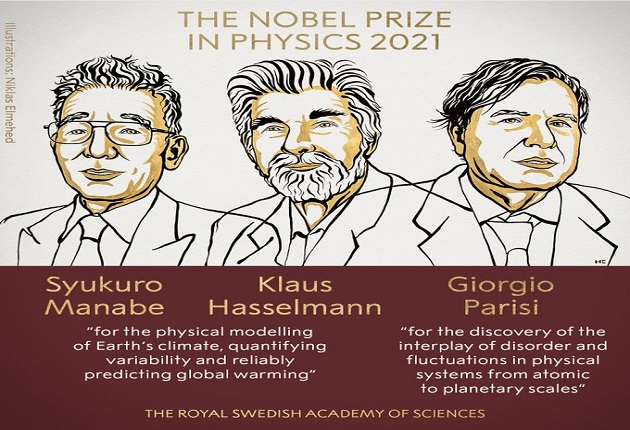
The Nobel Prize in Physics has gone to three scientists who sought to predict the long-term evolution of a complex system such as the climate by modelling variables — weather, human actions — that create disorder within those systems.
BREAKING NEWS:
— The Nobel Prize (@NobelPrize) October 5, 2021
The Royal Swedish Academy of Sciences has decided to award the 2021 #NobelPrize in Physics to Syukuro Manabe, Klaus Hasselmann and Giorgio Parisi “for groundbreaking contributions to our understanding of complex physical systems.” pic.twitter.com/At6ZeLmwa5
What is the link between the modelling of global warming, which earned Syukuro Manabe and Klaus Hasselmann half the prize, and the work of the third winner, Giorgio Parisi, who focused on the underlying disorder of matter?
All three study complex systems: large-scale climate or the behaviour of certain materials at an infinitely small scale. From the erratic fluctuations within these systems, the three physicists succeeded in teasing out simpler behaviours and reliable predictions.
Did you miss the announcement of the 2021 Nobel Prize in Physics earlier today?
— The Nobel Prize (@NobelPrize) October 5, 2021
Watch the very moment the prize was announced and see the full announcement at https://t.co/6cdrlGk1Si#NobelPrize pic.twitter.com/Gehb4dVkXK
« We recognised that emerging phenomena sometimes require us to look at all the individual complicated physical mechanisms and knit them together to make a prediction, » said Nobel Physics Committee member John Wettlaufer, on hand when the awards were announced in Stockholm on Tuesday.
Climate « is THE complex system par excellence, » said Freddy Bouchet, a physicist at France’s National Centre for Scientific Research.
A large number of variables, in other words, interact — atmosphere, oceans, soils, vegetation — rendering any reliable forecast beyond a few weeks elusive.
But alongside and within this observable chaos there are also clear trends that can be linked to well-identified causes, such as long-term global warming attributable to human activity.
Discover more about our 2021 physics laureate in this thread! #NobelPrize https://t.co/jntexwwCvt
— The Nobel Prize (@NobelPrize) October 5, 2021
– Hidden rules –
« In climate science, the random and the systematic overlap, » said Bouchet. « The mathematical tools developed by Klaus Hasselmann have made it possible to separate the two in order to better understand the evolution of climate. »
Being able to tease out patterns in what is random — the signal in the noise — is fundamental to understanding the evolution of extreme weather such as heat waves, storms and hurricanes.
The models developed by the Japanese-American Syukuro Manabe have succeeded in cracking the signature code of climate subsystems.
"It will take me a few days to answer all the phone calls that I had today."
— The Nobel Prize (@NobelPrize) October 5, 2021
Physics laureate Giorgio Parisi talks to us following the announcement of his #NobelPrize in Physics. pic.twitter.com/S2UrIMRzGy
« These are the first models which made it possible to calculate the effect of the increase in carbon dioxide of anthropogenic origin on global warming at the core of contemporary climate models », Bouchet said.
Giorgio Parisi, for his part, made a major contribution to the theory of these complex systems by revealing the hidden rules that govern them.
« I started to lay the foundations of this science — which did not exist at the beginning of the 1980s — by studying nature through mathematics », the Italian researcher told Corriere della Sera newspaper earlier this year.
It is a science that allows us, for example, to explain the changing form of a cloud of starlings in flight.
Parisi provided the mathematical tools to understand how random processes can play a decisive role in the development of large structures, such as those governing climate.
Today, they are applied in biology, neuroscience and artificial intelligence.

World Opinions News – Twitter




 World Opinions Débats De Société, Questions, Opinions et Tribunes.. La Voix Des Sans-Voix | Alternative Média
World Opinions Débats De Société, Questions, Opinions et Tribunes.. La Voix Des Sans-Voix | Alternative Média




